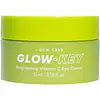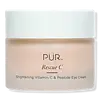What's inside
What's inside
 Key Ingredients
Key Ingredients

 Benefits
Benefits

 Concerns
Concerns

 Ingredients Side-by-side
Ingredients Side-by-side

Water
Skin ConditioningGlycerin
HumectantDiisostearyl Malate
EmollientHydrogenated Poly(C6-14 Olefin)
Emollient1,2-Hexanediol
Skin ConditioningEthylhexyl Palmitate
EmollientLimnanthes Alba Seed Oil
Skin ConditioningNiacinamide
SmoothingPentaerythrityl Tetraethylhexanoate
EmollientPolymethylsilsesquioxane
Myristyl Myristate
EmollientPEG-150 Distearate
EmulsifyingPolyglyceryl-3 Methylglucose Distearate
EmulsifyingCetearyl Alcohol
EmollientCI 77891
Cosmetic ColorantHydrogenated Olive Oil Lauryl Esters
Emulsion StabilisingPentylene Glycol
Skin ConditioningSqualane
EmollientEuphrasia Officinalis Extract
AntimicrobialHydrolyzed Hyaluronic Acid
HumectantAscorbic Acid
AntioxidantPalmitoyl Tripeptide-5
Skin ConditioningCamellia Sinensis Leaf Extract
AntimicrobialLuffa Cylindrica Fruit Extract
Skin ConditioningPsidium Guajava Fruit Extract
AstringentPsidium Guajava Leaf Extract
AstringentTocopherol
AntioxidantCyanocobalamin
Skin ConditioningCoffea Arabica Seed Extract
MaskingHydrogenated Lecithin
EmulsifyingGlyceryl Stearate
EmollientMica
Cosmetic ColorantHydroxyethyl Acrylate/Sodium Acryloyldimethyl Taurate Copolymer
Emulsion StabilisingCopernicia Cerifera Wax
Theobroma Grandiflorum Seed Butter
Skin ConditioningCaprylic/Capric Triglyceride
MaskingCaprylyl Glycol
EmollientBehenic Acid
CleansingSilica
AbrasiveSynthetic Fluorphlogopite
Stearic Acid
CleansingBehenyl Alcohol
EmollientStearyl Alcohol
EmollientHydrogenated Olive Oil Unsaponifiables
EmollientXanthan Gum
EmulsifyingParfum
MaskingEthylhexylglycerin
Skin ConditioningAdenosine
Skin ConditioningPolyglyceryl-10 Stearate
Skin ConditioningMyristic Acid
CleansingDisodium EDTA
Phenoxyethanol
PreservativeMelia Azadirachta Flower Extract
Skin ConditioningMelia Azadirachta Leaf Extract
Skin ConditioningCurcuma Longa Root Extract
MaskingOcimum Sanctum Leaf Extract
Skin ConditioningButylene Glycol
HumectantCorallina Officinalis Extract
Skin ConditioningAllium Sativum Bulb Extract
Skin ConditioningWater, Glycerin, Diisostearyl Malate, Hydrogenated Poly(C6-14 Olefin), 1,2-Hexanediol, Ethylhexyl Palmitate, Limnanthes Alba Seed Oil, Niacinamide, Pentaerythrityl Tetraethylhexanoate, Polymethylsilsesquioxane, Myristyl Myristate, PEG-150 Distearate, Polyglyceryl-3 Methylglucose Distearate, Cetearyl Alcohol, CI 77891, Hydrogenated Olive Oil Lauryl Esters, Pentylene Glycol, Squalane, Euphrasia Officinalis Extract, Hydrolyzed Hyaluronic Acid, Ascorbic Acid, Palmitoyl Tripeptide-5, Camellia Sinensis Leaf Extract, Luffa Cylindrica Fruit Extract, Psidium Guajava Fruit Extract, Psidium Guajava Leaf Extract, Tocopherol, Cyanocobalamin, Coffea Arabica Seed Extract, Hydrogenated Lecithin, Glyceryl Stearate, Mica, Hydroxyethyl Acrylate/Sodium Acryloyldimethyl Taurate Copolymer, Copernicia Cerifera Wax, Theobroma Grandiflorum Seed Butter, Caprylic/Capric Triglyceride, Caprylyl Glycol, Behenic Acid, Silica, Synthetic Fluorphlogopite, Stearic Acid, Behenyl Alcohol, Stearyl Alcohol, Hydrogenated Olive Oil Unsaponifiables, Xanthan Gum, Parfum, Ethylhexylglycerin, Adenosine, Polyglyceryl-10 Stearate, Myristic Acid, Disodium EDTA, Phenoxyethanol, Melia Azadirachta Flower Extract, Melia Azadirachta Leaf Extract, Curcuma Longa Root Extract, Ocimum Sanctum Leaf Extract, Butylene Glycol, Corallina Officinalis Extract, Allium Sativum Bulb Extract
Water
Skin ConditioningGlycerin
HumectantPropanediol
SolventCoco-Caprylate/Caprate
EmollientTrioctyldodecyl Citrate
EmollientStearic Acid
CleansingCoconut Alkanes
EmollientArachidyl Alcohol
EmollientCaprylyl Methicone
Skin ConditioningDimethicone
EmollientCaffeine
Skin ConditioningPanax Ginseng Root Extract
EmollientSqualane
EmollientAcetyl Hexapeptide-8
HumectantTocopherol
AntioxidantBehenyl Alcohol
EmollientArachidyl Glucoside
EmulsifyingSodium Polyacryloyldimethyl Taurate
Emulsion StabilisingPEG-12 Dimethicone/PPG-20 Crosspolymer
Xanthan Gum
EmulsifyingEthylhexylglycerin
Skin ConditioningAminopropyl Ascorbyl Phosphate
AntioxidantTetrasodium Glutamate Diacetate
Glucose
HumectantCaprylyl Glycol
EmollientPotassium Sorbate
PreservativeMica
Cosmetic ColorantCI 77891
Cosmetic ColorantCI 77491
Cosmetic ColorantWater, Glycerin, Propanediol, Coco-Caprylate/Caprate, Trioctyldodecyl Citrate, Stearic Acid, Coconut Alkanes, Arachidyl Alcohol, Caprylyl Methicone, Dimethicone, Caffeine, Panax Ginseng Root Extract, Squalane, Acetyl Hexapeptide-8, Tocopherol, Behenyl Alcohol, Arachidyl Glucoside, Sodium Polyacryloyldimethyl Taurate, PEG-12 Dimethicone/PPG-20 Crosspolymer, Xanthan Gum, Ethylhexylglycerin, Aminopropyl Ascorbyl Phosphate, Tetrasodium Glutamate Diacetate, Glucose, Caprylyl Glycol, Potassium Sorbate, Mica, CI 77891, CI 77491
Ingredients Explained
These ingredients are found in both products.
Ingredients higher up in an ingredient list are typically present in a larger amount.
Behenyl Alcohol is a type of fatty alcohol (these are different from the drying, solvent alcohols).
Fatty Alcohols have hydrating properties and are most often used as an emollient or to thicken a product. They are usually derived from natural fats and oils; behenyl alcohol is derived from the fats of vegetable oils.
Emollients help keep your skin soft and hydrated by creating a film that traps moisture in.
In 2000, Behenyl Alcohol was approved by the US as medicine to reduce the duration of cold sores.
Learn more about Behenyl AlcoholCaprylyl Glycol is a humectant and emollient, meaning it attracts and preserves moisture.
It is a common ingredient in many products, especially those designed to hydrate skin. The primary benefits are retaining moisture, skin softening, and promoting a healthy skin barrier.
Though Caprylyl Glycol is an alcohol derived from fatty acids, it is not the kind that can dry out skin.
This ingredient is also used as a preservative to extend the life of products. It has slight antimicrobial properties.
Learn more about Caprylyl GlycolCi 77891 is a white pigment from Titanium dioxide. It is naturally found in minerals such as rutile and ilmenite.
It's main function is to add a white color to cosmetics. It can also be mixed with other colors to create different shades.
Ci 77891 is commonly found in sunscreens due to its ability to block UV rays.
Learn more about CI 77891Ethylhexylglycerin (we can't pronounce this either) is commonly used as a preservative and skin softener. It is derived from glyceryl.
You might see Ethylhexylglycerin often paired with other preservatives such as phenoxyethanol. Ethylhexylglycerin has been found to increase the effectiveness of these other preservatives.
Glycerin is already naturally found in your skin. It helps moisturize and protect your skin.
A study from 2016 found glycerin to be more effective as a humectant than AHAs and hyaluronic acid.
As a humectant, it helps the skin stay hydrated by pulling moisture to your skin. The low molecular weight of glycerin allows it to pull moisture into the deeper layers of your skin.
Hydrated skin improves your skin barrier; Your skin barrier helps protect against irritants and bacteria.
Glycerin has also been found to have antimicrobial and antiviral properties. Due to these properties, glycerin is often used in wound and burn treatments.
In cosmetics, glycerin is usually derived from plants such as soybean or palm. However, it can also be sourced from animals, such as tallow or animal fat.
This ingredient is organic, colorless, odorless, and non-toxic.
Glycerin is the name for this ingredient in American English. British English uses Glycerol/Glycerine.
Learn more about GlycerinMica is a naturally occurring mineral used to add shimmer and color in cosmetics. It can also help improve the texture of a product or give it an opaque, white/silver color.
Serecite is the name for very fine but ragged grains of mica.
This ingredient is often coated with metal oxides like titanium dioxide. Trace amounts of heavy metals may be found in mica, but these metals are not harmful in our personal products.
Mica has been used since prehistoric times throughout the world. Ancient Egyptian, Indian, Greek, Roman, Aztec, and Chinese civilizations have used mica.
Learn more about MicaSqualane is an emollient that helps the skin hold onto moisture. It's an oily liquid that occurs naturally in certain types of fish and plant oils.
Because squalane boosts hydration in the skin, it also comes with plenty of benefits: it is an antioxidant and can help fight free radicals and skin damage. Squalane is also found to have a detoxifying effect when applied.
Squalane comes from squalene, which occurs naturally within the sebum of our skin. It is one of the oils our skin produces to keep itself hydrated. Squalane is the hydrogenated version of squalene and has a longer shelf life.
Research shows that squalane is non-irritating (even at 100% concentration).
In general, it's a fantastic ingredient. It does a great job at hydrating the skin, and it's suitable for those with sensitive skin.
The source of squalane may impact malassezia / fungal acne. This is because olive oil derived squalane can contain impurities such as fatty acids and plant waxes. Sugarcane derived squalane is recommended for anyone with malassezia concerns.
Is squalane vegan?
This depends on the source. Squalane can be derived from both plants and animals. Most squalane used in skincare comes from plants.
Please note: the source of squalane is only known if disclosed by the brand. We recommend reaching out to the brand if you have any questions about their squalane.
Read more about squalene with an "e".
Is squalane an oil?
Squalane is often called an oil, but it’s technically not; it’s a hydrocarbon, meaning it’s only made of carbon and hydrogen, unlike true oils which are triglycerides made of fatty acids and glycerol.
The term “oil-free” isn’t regulated, so companies can define it however they want. Some exclude all oils, while others just avoid mineral oil or comedogenic oils.
While some people avoid oils thinking they cause breakouts, the right kind of oil (or oil-like ingredient like squalane) can actually help balance and hydrate your skin. It’s worth testing out simple oils or squalane to see what works best for your skin.
Learn more about SqualaneStearic Acid is a fatty acid. It is an emollient, emulsifier, and texture enhancer.
As an emollient, stearic acid helps soften skin. It aids the skin's protective barrier by preventing water loss. It also provides a gentle cleansing effect without stripping away natural oils.
Stearic acid may also be used to enhance the texture of products. It can add volume and stabilize ingredients such as water and oil. This can help water and oil ingredients from separating.
Sources of stearic acid include animal or vegetable fats/oils such as coconut or shea. It can be naturally found in butter, cocoa butter, shea butter, vegetable fats, and animal tallow.
This ingredient may not be Malassezia folliculitis, or fungal-acne safe.
Learn more about Stearic AcidTocopherol (also known as Vitamin E) is a common antioxidant used to help protect the skin from free-radicals and strengthen the skin barrier. It's also fat soluble - this means our skin is great at absorbing it.
Vitamin E also helps keep your natural skin lipids healthy. Your lipid skin barrier naturally consists of lipids, ceramides, and fatty acids. Vitamin E offers extra protection for your skin’s lipid barrier, keeping your skin healthy and nourished.
Another benefit is a bit of UV protection. Vitamin E helps reduce the damage caused by UVB rays. (It should not replace your sunscreen). Combining it with Vitamin C can decrease sunburned cells and hyperpigmentation after UV exposure.
You might have noticed Vitamin E + C often paired together. This is because it is great at stabilizing Vitamin C. Using the two together helps increase the effectiveness of both ingredients.
There are often claims that Vitamin E can reduce/prevent scarring, but these claims haven't been confirmed by scientific research.
Learn more about TocopherolWater. It's the most common cosmetic ingredient of all. You'll usually see it at the top of ingredient lists, meaning that it makes up the largest part of the product.
So why is it so popular? Water most often acts as a solvent - this means that it helps dissolve other ingredients into the formulation.
You'll also recognize water as that liquid we all need to stay alive. If you see this, drink a glass of water. Stay hydrated!
Learn more about WaterXanthan gum is used as a stabilizer and thickener within cosmetic products. It helps give products a sticky, thick feeling - preventing them from being too runny.
On the technical side of things, xanthan gum is a polysaccharide - a combination consisting of multiple sugar molecules bonded together.
Xanthan gum is a pretty common and great ingredient. It is a natural, non-toxic, non-irritating ingredient that is also commonly used in food products.
Learn more about Xanthan Gum